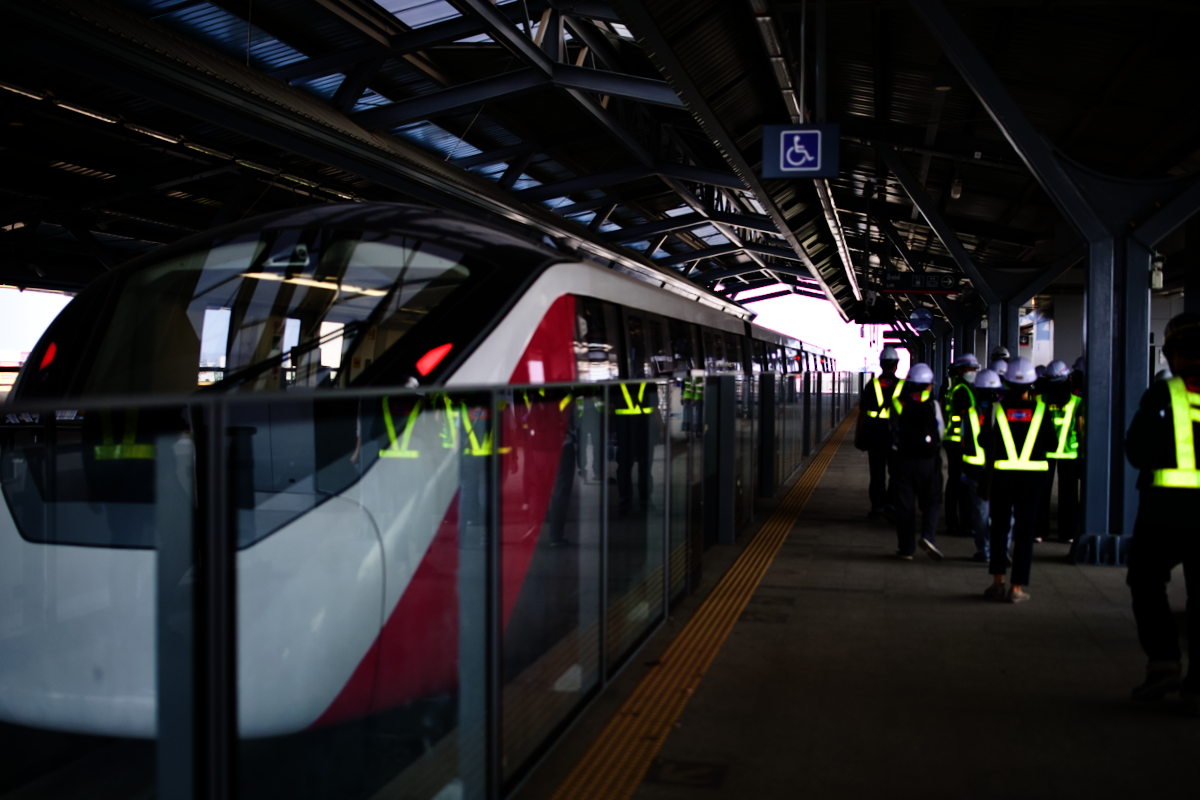
eXtensions - Sunday 5 March 2023
By Graham K. Rogers

The week ended with a visit to a new metro system in Bangkok. New Microsoft apps for the Mac are impressive but not the entering of passwords or recognition of phone numbers. Apple is moving operations out of China but some alternatives may have other problems to contend with. There are still decisions to be made on the value or credibility of written AI content, but there are also questions on how far should AI be used in photography and Art. The EU has decided to dilute its case against Apple.
At the end of the week I was able to make a visit to the new Pink Line monorail system that is to open in northern Bangkok soon. As well as a look at the workshops and trains in preparation, the group I was with took a ride on one of the test trains. The investment here and with the east Bangkok Yellow Line monorail system is massive. Both are fully automated: driverless like the Gold Line and the Bangkok APM; but able to run at higher speeds (max 80Kph).

On an Apple note, I took a couple of lenses with the Nikon D850 but instead of the iPad Pro I was carrying the Mac mini. With just under 150 photographs, I downloaded these from the camera to the iPad in the van on the ride back. With the large images (and the number) this was something I could not have done with my first 11" iPad Pro I had. The generation 6 iPad mini and the 11" M1 iPad Pro just import all these images without a pause. Using the Personal Hotspot while on the trip back I had about 30% populating the other devices by the time I arrived home. The Wifi there soon synchronized the rest

I have not been particularly pro-Microsoft in the last few years and have never used Windows. The last software I bought was MSDOS 6.0. Then I switched to Macs. I was quite impressed with the new Edge browser when I installed it looking for information on AI input, but I also had to download the Bing app. To use that, required me to register using a Microsoft email so I created an Outlook account. It was relatively painless initially, suggesting Redmond have learned about user interfacing. I was still unable to use the AI Chat feature in Bing, but that will be updated later, I was assured.
Later I was asked to confirm details and included the phone number: a code was sent. All perfectly normal. A few days later I was asked to sign in again, but the password was not recognized and when I tried to confirm details, the panel reported that it was unable to send a code to the telephone number entered: the same one I had registered with. I had to go the long way round, using a web page where I entered the same phone number and was sent a code instantly. The enter password panel does not recognise the phone number, but Microsoft obviously stores this and uses it when sending other information: Nescia sinistra quid faciat dextra.
This happened a few days later when I was asked to sign in to Bing again. Password not accepted, and phone number could not be used to send a code. However, when Outlook on the Mac was unable to connect and asked for the password, I entered the new one - the one I had just created. That was accepted and has been accepted on all the other devices, although I am not totally sure why Keychain did not synchronize the password.
Over the last few years, there have been plenty of comments about the need for Apple to move some of its manufacturing and assembly out of China. The resurgence of Covid 19 there, when cities were again shut down, leading to factory suspensions and subsequent unrest, hurried up the process, although this had already begun quietly in the background. Some of the moves in this part of the world included changes in Singapore, which has long been a favored base for Apple; a deal with the Vietnamese government which led to some openings there; expansion by Delta Electronics in Thailand; and of course India where Apple has long tried to enter the retail market against stiff protectionism. Moving some manufacturing there and creating more jobs, always pleases a government.
This has not been without problems of course as local factories are not run by Apple, nor are they often in the complete control of the parent companies. In 2021 Apple investigated an outbreak of food poisoning at a Foxconn factory in southern India which led to a strike (James Vincent, The Verge). The previous year, a Wistron factory in Bengaluru saw unrest after the local management was accused of failing to pay workers, with allegations of "extremely exploitative sweatshop-like working conditions in gross violation of labour laws" (Anuradha Nagaraj, Reuters).

This week there was a fire at another installation in India. Oliver Haslam (iMore) reports that a fire at an iPhone charging cable factory has put the building out of action for months and there is an expected loss of around $12m from this. I was interested to read that "While fire extinguishers were available, that's all that actually worked - smoke detectors, sprinklers, and fire hydrants were "non-functional," according to fire officials." Again this seems more that the local management have failed to live up to their responsibilities, leaving staff (and equipment) at risk to cut costs. This is not unusual in 3rd World countries - it's not unheard of in Europe or the USA for that matter - and there are countless examples of safety lapses.
Not far from where I am now, there was a massive fire at the Kader Toy factory which is described as "The worst industrial factory fire in history" (MercorTercresa) with 210 dead. A search brings up scores of entries including a Wikipedia page, many images, and a link to a documentary on YouTube. Apart from a worker who discarded a cigarette that is thought to have started the fire, all management personnel were cleared of charges for what appears to have been considerable negligence: at least Apple investigates and forces changes on the suppliers.
In PetaPixel this week there was an interview with British engineer and photographer Tim Helweg-Larsen who has developed a new idea: the Exposure Donut, or Expodo. This is a software tool designed to simplify exposure on mirrorless cameras with a 3-color display representing Aperture, Time and ISO. Each section, or arc has cells. The image is correctly exposed if the total number of cells adds up to 24. If the numbers add up to less than 24, it's underexposed (too dark). More than 24 and the photo is overexposed (Jeremy Gray).
The article itself has a couple of useful videos. In the first - an interview - Helweg-Larsen is asked to pitch the idea in 60 seconds which will be useful input for students who may be asked to pitch their project ideas. The video I have here is in Japanese, showing how Tim Helweg-Larsen is targeting the Japanese camera makers.
I have been looking a lot at the use of AI recently from my specific point of view as a teacher of English writing. Students need to come up with reports in English and other forms of writing, including journal articles and the thesis. These need to be written by the students as proof of ability and not churned out by some robot software. From what I have seen so far with such writing, my job is not at risk. These tools will improve and an example came my way this week from a student whom I have taught, who came up with a particularly clear example. As he is still an undergraduate (with good speaking skills) I asked him how he had done the. He had used an online tool, but not once. He had put the content through several times to improve it considerably.
There are other good examples, such as when lists have been produced quite quickly, or in commercial uses when product descriptions are developed. These do not need academic credibility and save much work for those who may have a range of tasks to do. I am willing to accept that there are uses for such content generating tools, even in an academic scenario, but there is a line that must not be crossed. As yet, we are not wholly sure where that line is as the tools we use normally, such as Autocorrect or Autos-suggest are probably now using AI to identify and offer solutions.
A couple of sources that may help shed some light on where to draw the line appeared in my sources this week: Jason Kottke, "The Octopus Test for Large Language Model AIs", 2 March 2023; and Jennifer Harker, "Science journals set new authorship guidelines for AI-generated text", Environmental Factor, March 2023. I was also sent an interesting approach in an Editorial from ACSNano, "Best Practices for Using AI When Writing Scientific Manuscripts". As there were some wordy sentences in the opening paragraph and a couple of odd word choices, I ran it through detector software in case it were a spoof, but it came back as "likely to have been written entirely by a human".
We have also made use of AI in photography and image editing for a while. Like writing, I am somewhat wary of using what is on offer, but I am aware that AI comes into play in even simple tasks like the Repair tool: usually Apple Photos and Pixelmator Pro on the Mac, and Pixelmator Photo on the iPad for me. The tools are much improved now and not only remove the problem (e.g dust) but without the background being damaged. That does not happen in all cases, but there is far more processing of the image even in this basic tool.
As such I am not against the idea of AI in photography for improved editing. In the past, with digital images, the way to produce the result that Repair does in a couple of seconds, was to work at the pixel level: painstakingly reconstructing the image pixels one by one. I have seen this done and a skillful editor could do a first-rate job of removing unwanted artifacts although it was time-consuming. If that pixel-by-pixel task is acceptable, then I would argue so is the addition of AI to the Repair tool to do the same task.
Where I draw the line is the use of this super-technology to change the image, or to add what was never there. I stopped using one image editor when, after a toll for enhancing the skies was introduced in one update, the developers produced a sunbeam feature in another. As the updates appeared, so the older apps I had relied on were no longer supported, despite the so-called forever license and I was already unhappy with the new releases (and purchases) when older versions were no longer working properly But the sunbeams fixed it for me as I began to notice images online with perfectly placed light tracks. This is hard to do. There is a famous photograph by Hal Morley of New York Central station sunbeams (no longer possible with the high rises now around the area).

|

|
It is hard to do. I managed a diluted version at a power station in Tak a few years back with an early digital camera, but it took me years to repeat the image with a film camera and it was nowhere near the quality of Morley's images.

|

|
I now see that a Vogue photographer has admitted that some of his images are made using AI (Matt Growcoot, PetaPixel). These are at least images used in Instagram rather than published images. I abhor the use of AI images, perhaps because part of my photography uses film, but accept the use of AI tools in editing. Where to draw the line? Perhaps, Like content used in journals: no co-authoring, but the use of such tools must be acknowledged. It is time to mark such images as AI-generated.
There is certainly a case for AI-assistance, particularly in artistic renditions which are clearly not based on reality - it would have taken graphic artists weeks to produce these in the past. But then I look at the works of some great artists working before the digital era and remember they never used digital assistants (or is that assistance?) Try Dali's Metamorphosis of Narcissus, or Breughel's Dulle Griet.
The EU has been gunning for Apple for a while now, along with politicians from several other countries, each taking what some think is a narrow view concerned only with potential monopoly while downplaying security and privacy. It is reported by several sources this week that the EU Commission has "narrowed its case against Apple" and that one of the major attack points, concerning the abuse of its position, has now been dropped (Patently Apple). There are still a number of points that the Commission wants addressed, but Apple is clearly happy about this. I wonder what Margrethe Vestager thinks now. She was quite confident that "Apple's conduct cannot be justified by security concerns" last year (Samuel Stolton, et al, Politico).
Graham K. Rogers teaches at the Faculty of Engineering, Mahidol University in Thailand. He wrote in the Bangkok Post, Database supplement on IT subjects. For the last seven years of Database he wrote a column on Apple and Macs. After 3 years writing a column in the Life supplement, he is now no longer associated with the Bangkok Post. He can be followed on Twitter (@extensions_th)

For further information, e-mail to
Back to
eXtensions
Back to
Home Page